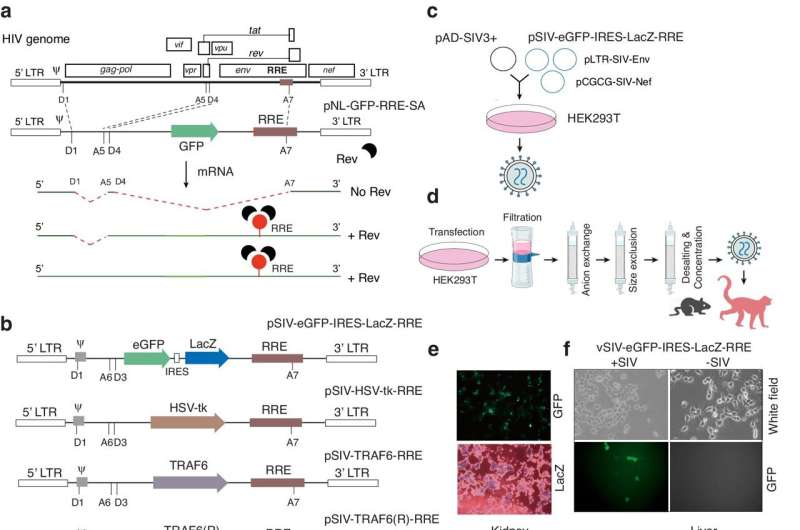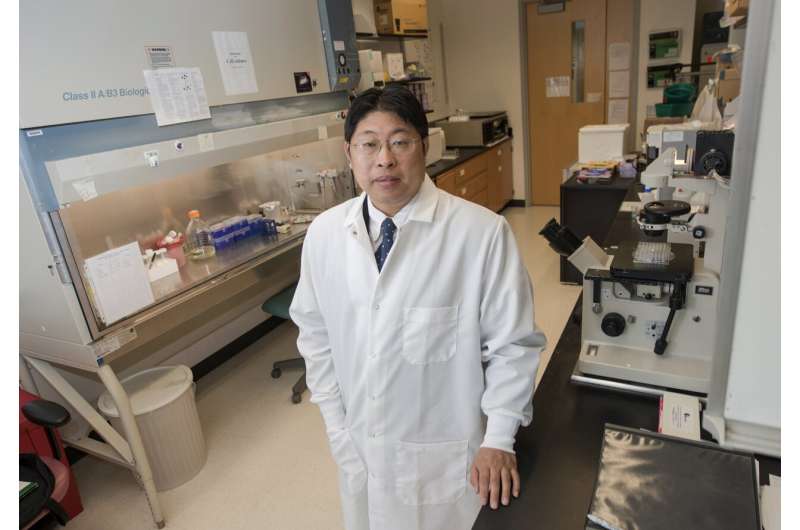This article has been reviewed according to Science X's editorial process and policies. Editors have highlighted the following attributes while ensuring the content's credibility:
fact-checked
peer-reviewed publication
trusted source
proofread
Proof-of-concept study finds HIV-like virus particle could end need for need for lifelong medications

Researchers in George Mason University's Center for Infectious Disease Research (CIDR) and Tulane National Primate Research Center have conducted a breakthrough proof-of-concept study, published in the journal Gene Therapy, that found an HIV-like virus particle that could cease the need for lifelong medications.
Scientists have made great strides in the treatment of HIV (human immunodeficiency virus) over the past few decades, yet those with the virus must still take antiretroviral therapy (ART) for life as the disease is difficult to eradicate.
Researchers at CIDR, led by Yuntao Wu, professor in George Mason's School of Systems Biology and the principal investigator of the study, developed a special HIV-like virus particle, called HIV Rev-dependent lentiviral vector, that uses an HIV protein, Rev, as a trigger to selectively target and activate therapeutic genes in HIV-infected cells. The Mason team, including Brian Hetrick, Mark Spear, Jia Guo, Huizhi Liang, Yajing Fu, Zhijun Yang, and Ali Andalibi, has been developing the HIV Rev-dependent vector technology since 2002.
According to Wu, patients need to take medications for the rest of their lives because of the persistence of HIV reservoirs, which are infected immune cells harboring the virus. Currently, ART used by patients can effectively block the virus, but cannot eliminate the viral reservoirs.
Experimental approaches such as "shock and kill" and "block and lock" of the reservoirs have been in development to either eliminate or silence viral reservoirs. Wu said the HIV Rev-dependent lentiviral vector technology, that his team has been developing, uses a different approach, which relies on the HIV Rev protein to selectively target reservoirs for killing or for inactivation.
"Our approach shows signs of not only reducing viral reservoirs but also boosting the immune system to produce antiviral neutralizing antibodies," said Wu. "Think about turning a bad guy into a good one."

The reservoir cells can be targeted by the Rev-dependent vector and be turned into releasing defective viruses that can act as a vaccine to stimulate neutralizing antibodies. Wu's team named this new approach "rehab and redeem" of the HIV reservoirs.
Scientists at Tulane National Primate Research Center, including Summer Siddiqui, Lara Doyle-Meyers, Bapi Pahar, Ronald S. Veazey, Jason Dufour, and Binhua Ling, collaborated with Wu's team to test this technology on monkeys infected with SIVmac239 (a virus similar to HIV), finding in one monkey that the virus levels in the blood and brain have been reduced to undetectable most of the time for over two years after cessation of ART administration.
According to Hetrick, this approach shows promise in controlling viremia and opens new avenues for developing effective treatments for HIV without relying on daily antiretrovirals.
"Our proof-of-concept animal studies demonstrate a step forward in the fight against this virus, bringing us closer to innovative and potentially transformative therapies for HIV patients," said Hetrick.
This proof-of-concept study signals what kinds of technologies could come for the 1.2 million people in the United States and 39 million worldwide (as of 2022) with HIV who depend on medications to keep the virus under control. Additional funded studies are needed to expand and optimize the animal studies, followed by human clinical trials serving as the next pivotal steps for the development of the new treatment.
"It took us 20 years to walk the first step; we will certainly keep going," Wu said.
More information: Brian Hetrick et al, Suppression of viral rebound by a Rev-dependent lentiviral particle in SIV-infected rhesus macaques, Gene Therapy (2024). DOI: 10.1038/s41434-024-00467-9





















